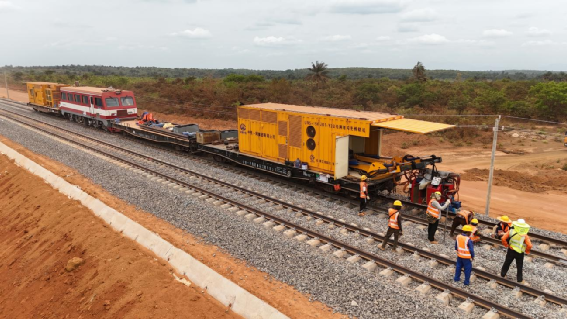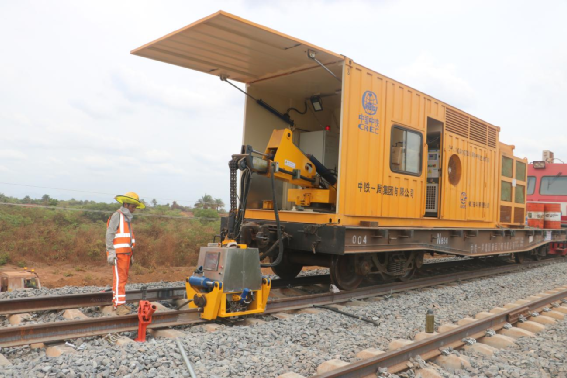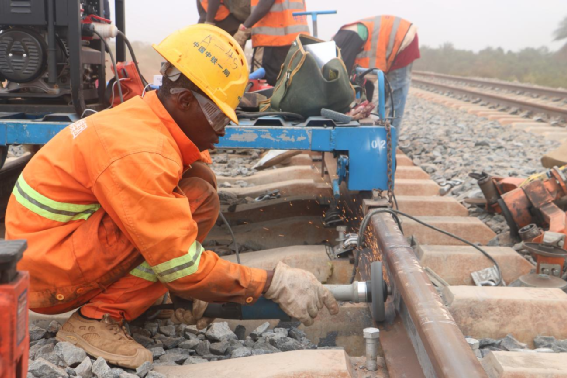
more>>Industry Overview
more>>Link us
News
Local time on April 10th, the noon sun in West Africa shone over the construction site at DK9 of the Maribaya Port-Musaya section of the Trans-Guinea Railway. Together with the sparkling welding sparks, it painted a vivid picture of bustling activity.

Long Rail Welding Construction Site
he Cross-Guinea Railway is a key supporting project for the large-scale mining of the world-class Simandou iron ore and the sea-rail intermodal transportation. It is jointly invested by WCH, Baowu Resources, Lituo Simfer and other shareholders, and supported by the operation preparation team of CTG. At present, the first section of long rail welding and stress release construction of the Cross-Guinea Railway MXTJ-01 bid section, undertaken by China Railway First Group, is advancing in an orderly manner.

Normalizing Operation with Mobile Rail Medium-Frequency Normalizer
China Railway First Group’s MXTJ-01 contract track-laying project encompasses the prefabrication and erection of 1,708 T-beams, 289.185 km of main line track-laying, and 61.058 km of station track-laying. A total of approximately 25,600 welds are required, with around 21,600 completed at the base rail welding line and 4,000 through on-site long rail welding. Since the railway entered the long rail welding and stress release phase on April 3rd, under the meticulous organization of Winning Consortium Simandou Railway Company, the project team has overcome challenges such as complex cross-construction coordination, cumbersome ballasted track procedures, language barriers, and extreme heat. Through the "Race to Complete Track-Laying for Opening" labor competition, Chinese and Guinean teams have collaborated closely, with scientific planning and efficient organization accelerating long rail laying, ballast unloading, and mechanical maintenance—laying a solid foundation for advancing long rail welding and stress release.
After undergoing a series of intricate processes including derusting, welding, normalizing, grinding, and flaw detection by workers, 300-meter-long rails are welded into 1.8-km rail units. These units are then transformed into continuous welded tracks through stress release and locking welding, steadily extending the railway forward.

Rail Grinding Operation
Cao Dezhi, the person in charge of China Railway First Group's MXTJ-01 bid section project, said: "The natural locking rail temperature must be between 35°C and 45°C to carry out stress release construction. Due to the large temperature difference in the local area, the rail temperature is too high during the day to meet the release conditions. To ensure the track quality and one-time formation of the line, the on-site workers adopt a two-shift operation mode of unit welding during the day and release and locking welding at night. The project department has built Africa's first intelligent rail welding production line, which welds 25-meter standard rails into 300-meter-long rails. After mechanized laying, mobile flash welding units are used for on-site welding, which improves work efficiency and construction quality."
"After flash welding, the rail joints need to be normalized. By reheating at a high temperature of 900 degrees, the internal grains of the steel are refined to ensure that the welds are closer to the original rail material, and the precision standard reaches zero error," said Ji Yongqiang, the rail welding technical person in charge of China Railway First Group's MXTJ-01 bid section project.
To comprehensively improve the efficiency of rail welding construction and safety management level, the company has put into use advanced automatic equipment and new technologies such as UN5-150ZB1 road-rail dual-purpose mobile flash welding machine, ZH120AJ1 mobile rail medium-frequency normalizing machine, and CNC precision grinder for welds. This has realized intelligent, information-based, professional and green rail welding construction, greatly improved the track quality, and ensured the smooth operation of the line in the later period.
Up to now, 8.68 kilometers of long rail welding and stress release have been completed in the Maribaya Port-Musaya section of the Cross-Guinea Railway, and the progress is advancing at a speed of 1.8 to 3.6 kilometers per day. It is expected that the long rail welding and stress release construction of the first section will be completed by the end of May, and all long rail welding and stress release construction tasks within the bid section will be completed by the end of September. At that time, it will fully enter the stages of line fine tamping and static acceptance.
Source: China Railway First Group Xinyun Company